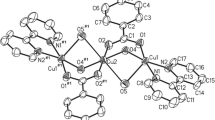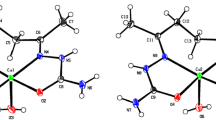Abstract
Four new coordination compounds of Cu(II) were synthesized with ethyl-5-amino-1-methyl-1H-pyrazole-4-carboxylate (L) and different co-ligands. In the reaction of warm methanolic solutions of CuX2·nH2O (X = Cl, n = 2; X = Br, n = 0; X = NO3, n = 3) and the ligand in mole ratio 1:2, bis(ligand) complexes Cu(L)2Cl2 (1), Cu(L)2Br2 (2) and Cu(L)2(NO3)2 (3) were obtained. Unlike this, reaction of CuCl2 with the ligand in the presence of LiOAc yielded to the formation of dimeric complex of the formula [Cu(L)(OAc)2]2 (4), with four acetate ions as bridging ligands. In all these complexes, ligand L is coordinated in a monodentate manner through N2 nitrogen atom. The coordination environment in the dimeric complex is octahedral, while in the monomeric complexes the central atom is tetra-coordinated. The molar conductivity data in DMF show that the acetate ions in the dimeric complex are coordinated even in solution. In the monomeric compounds, the molar conductivity data increase in the order 1 < 2 < 3. Since the applicability of the coordination compounds depends on their thermal properties, the thermal decomposition of the complexes was followed by simultaneous TG–DSC measurements. The thermal stability of the monomeric compounds in flowing argon increases in the reverse order as the molar conductivity data. The course of the decomposition is different in the case of the nitrato-compound (3). The decomposition of 3 is followed by a strong exothermic heat effect due to the presence of nitrate ion which is a strong oxidation agent. The decomposition of the other complexes is endothermic, taking place in more or less overlapped reactions. The decomposition of the compounds is completed to 600 °C.







Similar content being viewed by others

Notes
The solvolytic stability shows the rate of nucleophilic substitution of coordinated anions of a coordination compound by solvent molecules. This property is of great importance for the bioavailability of the compounds.
References
Rajapakshe A, Snyder RA, Astashkin AV, Bernardson P, Evans DJ, Young CG, Evans DH, Enemark JH. Insights into the nature of Mo(V) species in solution: modeling catalytic cycles for molybdenum enzymes. Inorg Chim Acta. 2009;362:4603–8.
Sharma S, Srivastavav VK, Kumar A. Newer N-substituted anthranilic acid derivatives as potent anti-inflammatory agents. Eur J Med Chem. 2002;37:689–97.
Maggio B, Daidone G, Raffa D, Plescia S, Mantione L, Catena Cutuli VM, Mangano NG, Caruso A. Synthesis and pharmacological study of ethyl 1-methyl-5-(substituted 3,4-dihydro-4-oxoquinazolin-3-yl)-1H-pyrazole-4-acetates. Eur J Med Chem. 2001;36:737–42.
El-Hawash SAM, Badawey ESAM, El-Ashmawey IM. Nonsteroidal antiinflammatory agents—part 2. Antiinflammatory, analgesic and antipyretic activity of some substituted 3-pyrazolin-5-ones and 1,2,4,5,6,7-3H-hexahydroindazol-3-ones. Eur J Med Chem. 2006;41:155–65.
Vlaicu ID, Olar R, Marinescu D, Lazar V, Badea M. Physico-chemical and thermal characterisation of new Co(II) complexes with pyrazole derivatives. J Therm Anal Calorim. 2013;113:1337–43.
Soliman SM, Almarhoon Z, Sholkamy EN, El-Faham A. Bis-pyrazolyl-s-triazine Ni(II) pincer complexes as selective gram positive antibacterial agents; synthesis, structural and antimicrobial studies. J Mol Struct. 2019;1195:315–22.
Dutta S, Padhye S, Ahmed F, Sarkar F. Pyridazolate-bridged dicopper (II) SOD mimics with enhanced antiproliferative activities against estrogen and androgen independent cancer cell lines. Inorg Chim Acta. 2005;358:3617–24.
Lamberth C. Pyrazole chemistry in crop protection. Heterocycles. 2007;71:1467–502.
Li HB, Zhu YQ, Song XW, Hu FZ, Liu B, Li YH, Niu ZX, Liu P, Wang ZH, Song HB, Zou XM, Yang HZ. Novel protoporphyrinogen oxidase inhibitors: 3H-Pyrazolo[3,4-d][1,2,3]triazin-4-one derivatives. J Agric Food Chem. 2008;56:9535–42.
Messerle BA, Page MJ, Turner P. Rhodium(I) and iridium(I) complexes of pyrazolyl-N-heterocyclic carbene ligands. Dalton Trans. 2006;32:3927–33.
Hosny NM. Solvothermal synthesis, thermal and adsorption properties of metal-organic frameworks Zn and CoZn(DPB). J Therm Anal Calorim. 2015;122:89–95.
Netto AVG, Frem RCG, Mauro AE, Crespi MS, Zorel HE Jr. Synthesis, spectral and thermal studies on pyrazolate bridged palladium(II) coordination polymers. J Therm Anal Calorim. 2007;87:789–92.
El-Kadri OM, Heeg MJ, Winter CH. Synthesis, structure, properties, volatility, and thermal stability of molybdenum(II) and tungsten(II) complexes containing allyl, carbonyl, and pyrazolate or amidinate ligands. J Organomet Chem. 2009;694:3902–11.
Zhao J, Jin B, Peng R, Liu Q, Tan B, Chu S. Synthesis and characterization of a new energetic salt 1Hpyrazole-1-carboxamidine dinitramide and its thermal properties. J Therm Anal Calorim. 2016;124:1431–9.
Jaćimović Ž, Kosović M, Kastratović V, Barta Holló B, Mészáros Szécsényi K, Szilágyi IM, Latinović N, Vojinović-Ješić L, Rodić M. Synthesis and characterization of copper, nickel, cobalt, zinc complexes with 4-nitro-3-pyrazolecarboxylic acid ligand. J Therm Anal Calorim. 2018;133:813–21.
Jaćimović Ž, Giester G, Kosović M, Bogdanović GA, Novaković SB, Leovac VM, Latinović N, Barta Holló B, Mészáros Szécsényi K. Pyrazole-type complexes with Ni(II) and Cu(II). Solvent exchange reactions in coordination compounds. J Therm Anal Calorim. 2017;127:1501–9.
Mészáros Szécsényi K, Leovac VM, Jaćimović Ž, Češljević VI, Kovács A, Pokol G. Transition metal complexes with pyrazole-based ligands. Part 12. Characterisation and thermal decomposition of CuCl2 complexes with di- and trisubstituted pyrazoles. J Therm Anal Calorim. 2001;66:573–81.
Tanasković SB, Antonijević-Nikolić M, Barta Holló B, Dražić B, Stanojković T, Mészáros Szécsényi K, Vučković G. Correlations between the in vitro antiproliferative activity, structure and thermal stability of some macrocyclic dinuclear Cu(II) complexes. J Serb Chem Soc. 2014;79:1235–47.
Magyari J, Barta Holló B, Vojinović-Ješić L, Radanović M, Armaković S, Armaković SJ, Molnár J, Kincses A, Gajdács M, Spengler G, Mészáros Szécsényi K. Interactions of Schiff base compounds and their coordination complexes with the drug cisplatin. New J Chem. 2018;42:5834–43.
Holló B, Rodić MV, Vojinović-Ješić LS, Živković-Radovanović V, Vučković G, Leovac VM, Mészáros Szécsényi K. Crystal structure, thermal behavior, and microbiological activity of a thiosemicarbazide-type ligand and its cobalt complexes. J Therm Anal Calorim. 2014;116:655–62.
Rigaku Oxford Diffraction. CrysAlisPro Software system. Oxford: Rigaku Corporation; 2018.
Busing WR, Levy HA. High-speed computation of the absorption correction for single crystal diffraction measurements. Acta Cryst. 1957;10:180–2.
Sheldrick GM. SHELXT—integrated space-group and crystal-structure determination. Acta Crystallogr. 2015;A71:3–8. https://doi.org/10.1107/S2053273314026370.
Sheldrick GM. Crystal structure refinement with SHELXL. Acta Crystallogr. 2015;C71:3–8. https://doi.org/10.1107/S2053229614024218.
Hübschle CB, Sheldrick GM, Dittrich B. ShelXle: a Qt graphical user interface for SHELXL. J Appl Crystallogr. 2011;44:1281–4. https://doi.org/10.1107/S0021889811043202.
Spek AL. Structure validation in chemical crystallography. Acta Crystallogr. 2009;D65:148–55. https://doi.org/10.1107/S090744490804362X.
Turner MJ, Grabowsky S, Jayatilaka D, Spackman MA. Accurate and efficient model energies for exploring intermolecular interactions in molecular crystals. J Phys Chem Lett. 2014;5:4249–55.
Turner MJ, Thomas SP, Shi MW, Jayatilaka D, Spackman MA. Energy frameworks: insights into interaction anisotropy and the mechanical properties of molecular crystals. Chem Commun. 2015;51:3735–8.
Mackenzie CF, Spackman PR, JayatilakaD Spackman MA. Crystal explorer model energies and energy frameworks: extension to metal coordination compounds, organic salts, solvates and open-shell systems. IUCrJ. 2017;4:575–87.
Turner J, McKinnon JJ, Wolff SK, Grimwood DJ, Spackman PR, Jayatilaka D, Spackman MA. CrystalExplorer 17; 2017. University of Western Australia. http://hirshfeldsurface.net. Accessed 1 Aug 2019.
Geary WJ. The use of conductivity measurements in organic solvents for the characterization of coordination compounds. Coord Chem Rev. 1971;7:81–122.
Ali I, Wani WA, Saleem K. Empirical formulae to molecular structures of metal complexes by molar conductance. Synth React Inorg Metal-Org Nano-Met Chem. 2013;43:1162–70.
Sánchez-Féreza F, Bayésb L, Font-Bardiac M, Pons J. Solvent dependent formation of Cu(II) complexes based on isonicotinamide ligand. Inorg Chim Acta. 2019;494:112–22.
Groom R, Bruno IJ, Lightfoot MP, Ward SC. The Cambridge structural database. Acta Cryst. 2016;B72:171–9.
Addison AW, Rao TN, Reedijk J, Van Rijn J, Verschoor GC. Synthesis, structure, and spectroscopic properties of copper (II) compounds containing nitrogen–sulphur donor ligands; the crystal and molecular structure of aqua [1,7-bis (N-methylbenzimidazol-2′-yl)-2,6-dithiaheptane] copper (II) perchlorate. J Chem Soc Dalton Trans. 1984;7:1349–56.
Holmes RR. Five-coordinated structures. In: Lippard SJ, editor. Progress in inorganic chemistry, vol. 32. Amsterdam: Wiley; 1984. p. 119–235.
Szpakowska M, Uruska I, Teszner R. Thermogravimetric investigation of some mononuclear and binuclear complexes of copper(II) acetate with pyridine derivatives. J Therm Anal. 1987;32:717–28.
Obaid AY, Alyoubi AO, Samarkandy AA, Al-Thabaiti SA, Al-Juaid SS, El-Bellihi AA, El-HM Deifallah. Kinetics of thermal decomposition of copper(II) acetate monohydrate. J Therm Anal Calorim. 2000;61:985–94.
Holló B, Magyari J, Živković-Radovanovi V, Vučković G, Tomić ZD, Szilágyi IM, Pokol G, Mészáros Szécsényi K. Synthesis, characterisation and antimicrobial activity of bis(phthalazine-1-hydrazone)-2,6-diacetylpyridine and its complexes with CoIII, NiII, CuII and ZnII. Polyhedron. 2014;80:142–50.
Kovács GB, May NV, Bombicz PA, Klébert S, Németh P, Menyhárd A, Novodárszki G, Petrusevski V, Franguelli FP, Magyari J, Béres K, Szilágyi IM, Kótai L. An unknown component of a selective and mild oxidant: structure and oxidative ability of a double salt-type complex having κ1O-coordinated permanganate anions and three- and four-fold coordinated silver cations. RSC Adv. 2019;9:28387–98.
Acknowledgements
This work was supported by the Ministry of Education, Science and Technological Development of the Republic of Serbia (Grant No. 172014) and by Montenegrian Ministry of Sciences (Bilateral cooperation project Montenegro–Serbia of the period 15.10.2016–15.10.2018).
Author information
Authors and Affiliations
Corresponding author
Additional information
Publisher's Note
Springer Nature remains neutral with regard to jurisdictional claims in published maps and institutional affiliations.
Rights and permissions
About this article
Cite this article
Barta Holló, B., Vojinović Ješić, L.S., Radanović, M.M. et al. Synthesis, physicochemical, and thermal characterization of coordination compounds of Cu(II) with a pyrazole-type ligand. J Therm Anal Calorim 142, 451–460 (2020). https://doi.org/10.1007/s10973-020-09260-3
Received:
Accepted:
Published:
Issue Date:
DOI: https://doi.org/10.1007/s10973-020-09260-3



